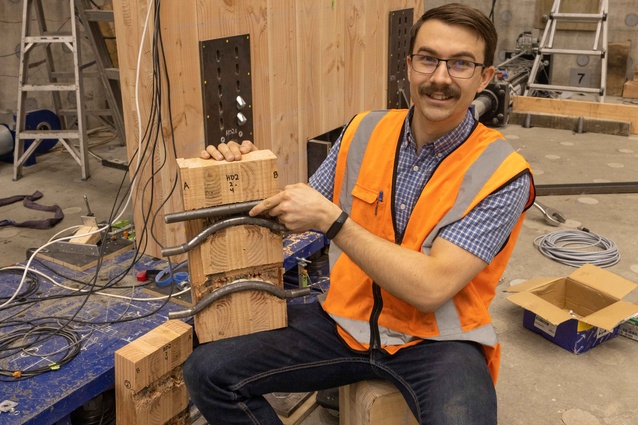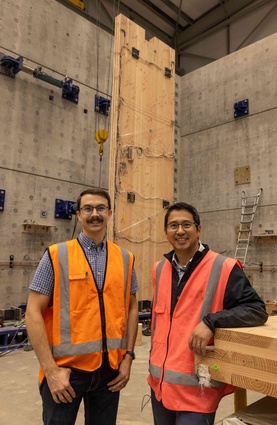EQC claim “stunning” results for CLT in latest research
New research claims cross-laminated timber (CLT) walls are feasible and cost-competitive with steel or concrete systems in low-rise buildings and could offer significant environmental benefits.
The findings from EQC-funded research by Associate Professor Minghao Li and his team at the University of Canterbury (UC) could have far-reaching implications for the construction and forestry industries and New Zealand’s quest to become a carbon-neutral economy.
Associate Professor Li and his PhD student Ben Moerman have been testing large CLT shear walls in the UC Structural Engineering Laboratory to find out how these multi-storey walls behave in significant earthquakes. “We loaded the walls horizontally to create a similar scenario of multi-storey CLT buildings in big earthquakes like the ones in Christchurch,” explains Associate Professor Li, who points out that the weight of timber is only one-fifth of concrete, meaning much lower earthquake loads, but engineered timber has similar strength as concrete. “With the right connections, CLT buildings can be really strong and resilient in an earthquake.”
The research team designed innovative high-capacity connections to resist earthquake forces and protect the integrity of the timber walls. “We have tested those large-capacity connections that tie the walls down to the foundations to study their performance in an earthquake,” explains Moerman, who was excited to see that steel dowels in the connections would bend to absorb energy and prevent the walls from being significantly damaged or collapsing. “The main benefit is that after an earthquake you can simply replace the dowels and the buildings will be just as strong as they were before the earthquake,” says Moerman.
The research in Christchurch claims to have major environmental implications as the construction industry contributes around 40 percent of global CO2 emissions, while New Zealand’s building industry contributes around 20 percent of the country’s carbon footprint. “If we can put more wood from sustainable plantations into buildings, we can lock carbon into those buildings for at least 50 years, which will have great benefits for New Zealand to achieve our carbon-neutral goals,” says the project lead. “New Zealand has 2.1 million hectares of plantation forests and we grow a lot of high-quality timber, like radiata pine that we can use for construction. We hope our research will convince the building industry to use more timber, which will also benefit our forestry industry.” Associate Professor Minghao Li acknowledges that currently engineered timber materials might be slightly more expensive than other materials, but the speed of construction and limited resources required may also make timber a cost-competitive building solution.











